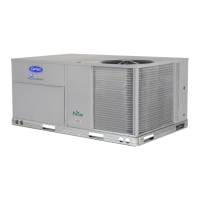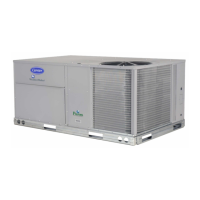94
CCN OAQ Broadcast (OAQ.B)
If this configuration is set to ON, the control will periodically
broadcast its outside air quality reading at a rate of once every
30 minutes.
Global Schedule Broadcast (G.S.B)
If this configuration is set to ON and the schedule number
(SCH.N) is between 65 and 99, then the control will broadcast
the internal time schedule once every 2 minutes.
CCN Broadcast Acknowledger (B.ACK)
If this configuration is set to ON, then when any broadcasting is
done on the bus, this device will respond to and acknowledge.
Only one device per bus can be configured for this option.
Schedule Number (SCH.N)
This configuration determines what schedule the control may
follow.
SCH.N = 0 The control is always occupied.
SCH.N = 1 The control follows its internal time schedules.
The user may enter any number between 1 and
64 but it will be overwritten to “1” by the con-
trol as it only has one internal schedule.
SCH.N = 65-99 The control is either set up to receive to a
broadcasted time schedule set to this number
or the control is set up to broadcast its internal
time schedule (G.S.B) to the network and this
is the global schedule number it is broadcast-
ing. If this is the case, then the control still fol-
lows its internal time schedules.
Accept Global Holidays? (HOL.T)
If a device is broadcasting the time on the bus, it is possible to
accept the time yet not accept the global holiday from the
broadcast message.
Override Time Limit (O.T.L)
This configuration allows the user to decide how long an over-
ride occurs when it is initiated. The override may be config-
ured from 1 to 4 hours. If the time is set to 0, the override func-
tion will become disabled.
Timed Override Hours (OV.EX)
This displays the current number of hours left in an override. It
is possible to cancel an override in progress by writing “0” to
this variable, thereby removing the override time left.
SPT Override Enabled? (SPT.O)
If a space sensor is present, then it is possible to override an
unoccupied period by pushing the override button on the T55
or T56 sensor. This option allows the user to disable this func-
tion by setting this configuration to NO.
T58 Override Enabled? (T58.O)
The T58 sensor is a CCN device that allows cooling/heating set
points to be adjusted, space temperature to be written to the
rooftop unit, and the ability to initiate a timed override. This
option allows the user to disable the override initiated from the
T58 sensor by setting this option to NO.
Global Schedule Override? (GL.OV)
If the control is set to receive global schedules, then it is also pos-
sible for the global schedule broadcaster to call out an override
condition as well. This configuration allows the user to disable the
global schedule broadcaster from overriding the control.
Alert Limit Configuration
The ALLM submenu is used to configure the alert limit set
points. A list is shown in Table 74.
SPT Low Alert Limit/Occ (SP.L.O)
If the space temperature is below the configurable occupied SPT
Low Alert Limit (SP.L.O), then Alert 300 will be generated and
the unit will be stopped. The alert will automatically reset.
SPT High Alert Limit/Occ (SP.H.O)
If the space temperature is above the configurable occupied
SPT High Alert Limit (SP.H.O), then Alert 301 will be gener-
ated and the unit will be stopped. The alert will automatically
reset.
SPT Low Alert Limit/Unocc (SP.L.U)
If the space temperature is below the configurable unoccupied
SPT Low Alert Limit (SP.L.U), then Alert 300 will be generated
and the unit will be stopped. The alert will automatically reset.
SPT High Alert Limit/Unocc (SP.H.U)
If the space temperature is above the configurable unoccupied
SPT High Alert Limit (SP.H.U), then Alert 301 will be gener-
ated and the unit will be stopped. The alert will automatically
reset.
Table 74 — Alert Limit Configuration
ITEM EXPANSION RANGE UNITS CCN POINT DEFAULT
SP.L.O SPT lo alert limit/occ –10 to 245 dF SPLO 60
SP.H.O SPT hi alert limit/occ –10 to 245 dF SPHO 85
SP.L.U SPT lo alert limit/unocc –10 to 245 dF SPLU 45
SP.H.U SPT hi alert limit/unocc –10 to 245 dF SPHU 100
SA.L.O EDT lo alert limit/occ –40 to 245 dF SALO 40
SA.H.O EDT hi alert limit/occ –40 to 245 dF SAHO 100
SA.L.U EDT lo alert limit/unocc –40 to 245 dF SALU 40
SA.H.U EDT hi alert limit/unocc –40 to 245 dF SAHU 100
RA.L.O RAT lo alert limit/occ –40 to 245 dF RALO 60
RA.H.O RAT hi alert limit/occ –40 to 245 dF RAHO 90
RA.L.U RAT lo alert limit/unocc –40 to 245 dF RALU 40
RA.H.U RAT hi alert limit/unocc –40 to 245 dF RAHU 100
OAT.L OAT lo alert limit –40 to 245 dF OATL –40
OAT.H OAT hi alert limit –40 to 245 dF OATH 150
R.RH.L RARH low alert limit 0 to 100 % RRHL 0
R.RH.H RARH high alert limit 0 to 100 % RRHH 100
O.RH.L OARH low alert limit 0 to 100 % ORHL 0
O.RH.H OARH high alert limit 0 to 100 % ORHH 100
SP.L SP low alert limit 0 to 5 " H2O SPL 0
SP.H SP high alert limit 0 to 5 " H2O SPH 2
BP.L BP lo alert limit –0.25 to 0.25 " H2O BPL –0.25
BP.H BP high alert limit –0.25 to 0.25 " H2O BPH 0.25
IAQ.H IAQ high alert limit 0 to 5000 IAQH 1200

